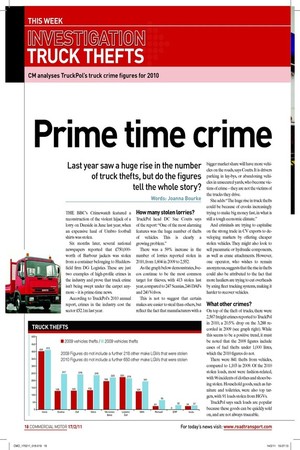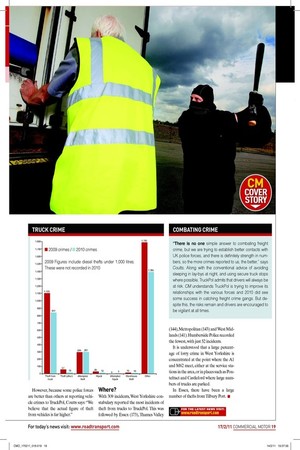Prime time crime
Page 14

Page 15

If you've noticed an error in this article please click here to report it so we can fix it.
Last year saw a huge rise in the number of truck thefts, but do the figures tell the whole story?
Words: Joanna Bourke
THE BBC’s Crimewatch featured a reconstruction of the violent hijack of a lorry on Deeside in June last year, when an expensive haul of Umbro football shirts was stolen.
Six months later, several national newspapers reported that £750,000worth of Barbour jackets was stolen from a container belonging to Huddersield irm DG Logistics. These are just two examples of high-proile crimes in the industry and prove that truck crime isn’t being swept under the carpet anymore – it is prime-time news.
According to TruckPol’s 2010 annual report, crimes in the industry cost the sector £52.1m last year.
How many stolen lorries?
TruckPol head DC Sue Coutts says of the report: “One of the most alarming features was the huge number of thefts of vehicles. This is clearly a growing problem.” There was a 59% increase in the number of lorries reported stolen in 2010, from 1,604 in 2009 to 2,552.
As the graph below demonstrates, Ivecos continue to be the most common target for thieves, with 413 stolen last year, compared to 247 Scanias, 246 DAFs and 240 Volvos.
This is not to suggest that certain makes are easier to steal than others, but relect the fact that manufacturers with a bigger market share will have more vehicles on the roads, says Coutts. It is drivers parking in lay-bys, or abandoning vehicles in unsecured yards, who become victims of crime – they are not the victims of the trucks they drive.
She adds: “The huge rise in truck thefts could be because of crooks increasingly trying to make big money fast, in what is still a tough economic climate.” And criminals are trying to capitalise on the strong trade in CV exports to developing markets by offering cheaper stolen vehicles. They might also look to sell pneumatic or hydraulic components, as well as crane attachments. However, one operator, who wishes to remain anonymous, suggests that the rise in thefts could also be attributed to the fact that more hauliers are trying to cut overheads by axing leet tracking systems, making it harder to recover vehicles.
What other crimes?
On top of the theft of trucks, there were 2,567 freight crimes reported to TruckPol in 2010, a 20.5% drop on the 3,288 recorded in 2009 (see graph right). While this seems to be a positive trend, it must be noted that the 2009 igures include cases of fuel thefts under 1,000 litres, which the 2010 igures do not.
There were 841 thefts from vehicles, compared to 1,103 in 2009. Of the 2010 stolen loads, most were fashion-related, with 96 incidents of clothes and shoes being stolen. Household goods, such as furniture and toiletries, were also top targets, with 91 loads stolen from HGVs.
TruckPol says such loads are popular because these goods can be quickly sold on, and are not always traceable. However, because some police forces are better than others at reporting vehicle crimes to TruckPol, Coutts says: “We believe that the actual igure of theft from vehicles is far higher.”
Where?
With 309 incidents, West Yorkshire constabulary reported the most incidents of theft from trucks to TruckPol. This was followed by Essex (173), Thames Valley (144), Metropolitan (143) and West Midlands (141). Humberside Police recorded the fewest, with just 52 incidents.
It is understood that a large percentage of lorry crime in West Yorkshire is concentrated at the point where the A1 and M62 meet, either at the service stations in the area, or in places such as Pontefract and Castleford where large numbers of trucks are parked.
In Essex, there have been a large number of thefts from Tilbury Port. ■
FOR THE LATEST NEWS VISIT:
www.roadtransport.com












































